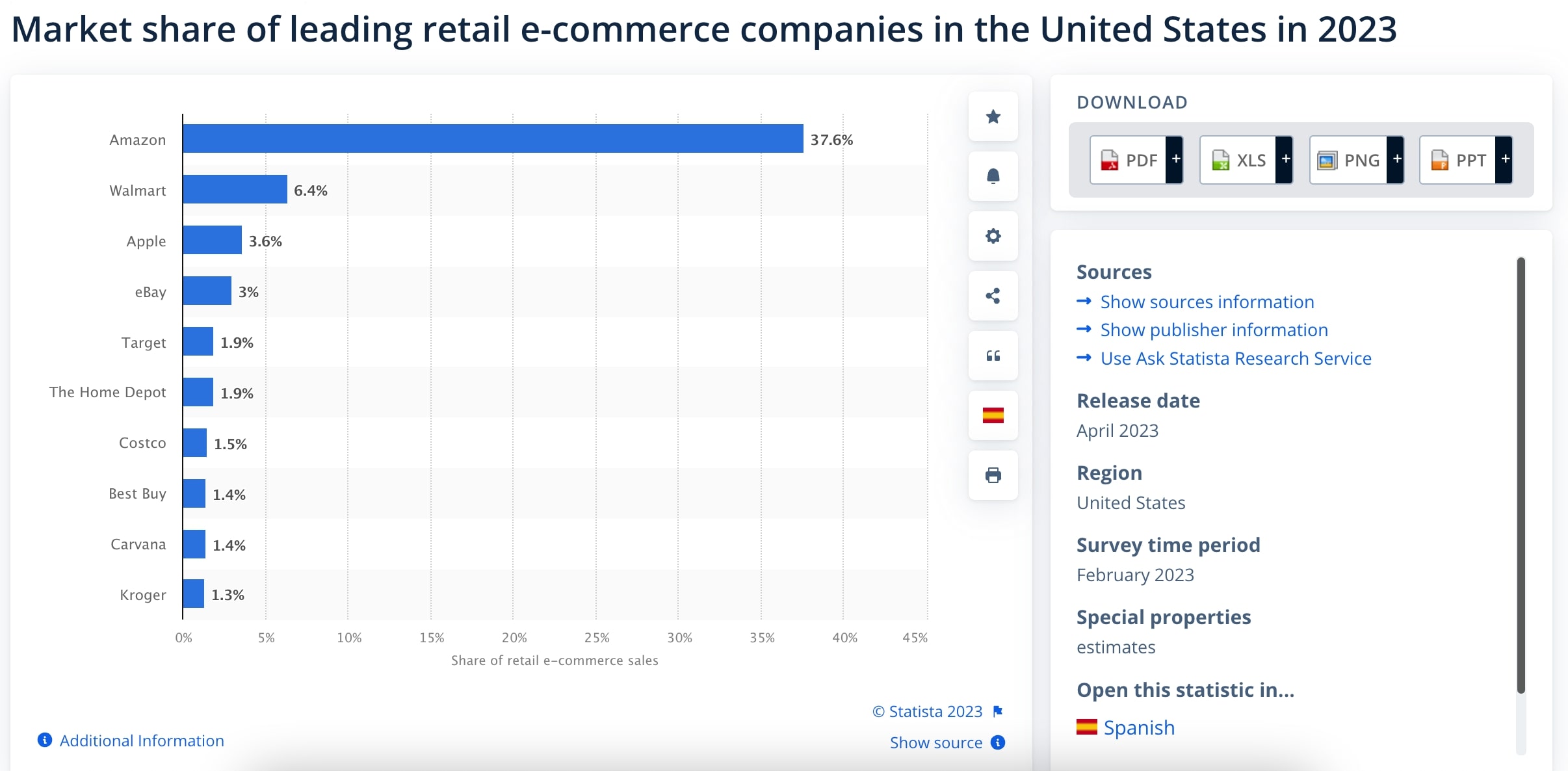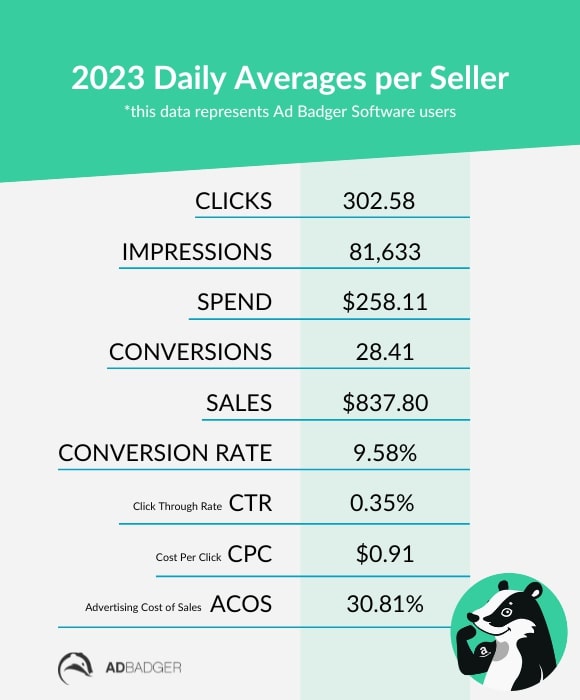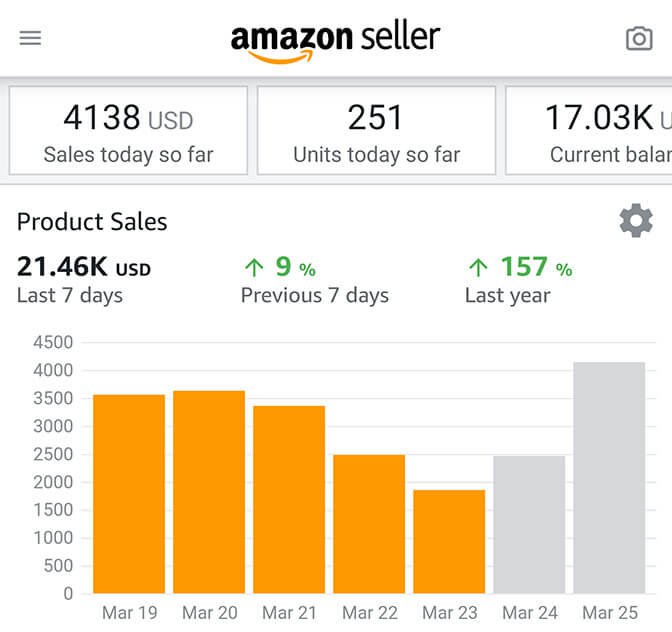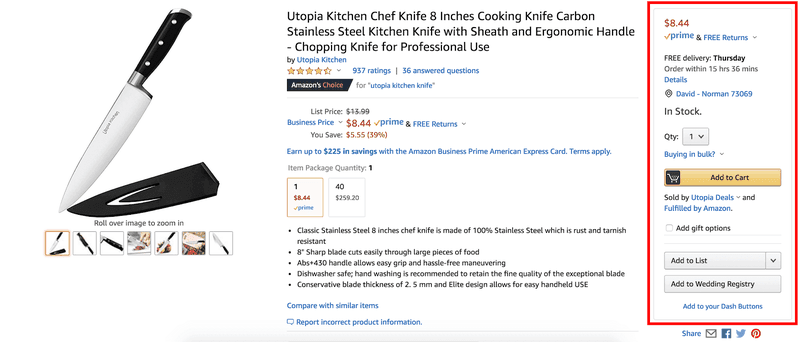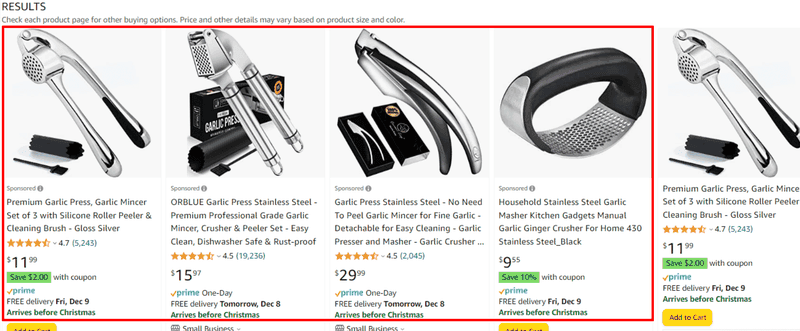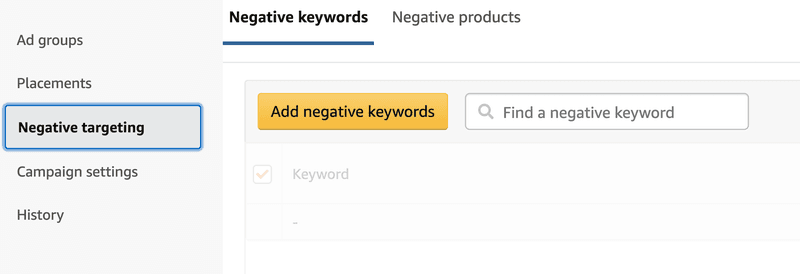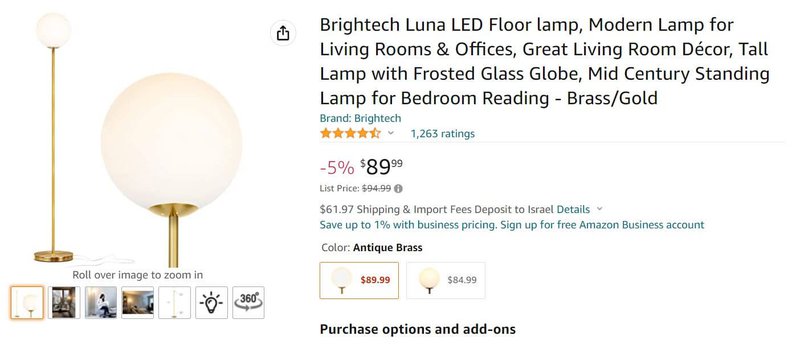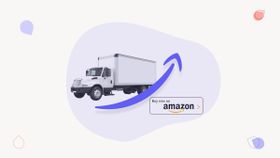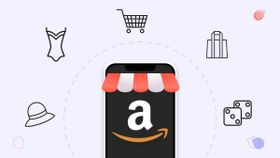Amazon PPC Made Simple: A Step-by-Step Guide for 2025
The Comprehensive Guide to Amazon Ads. Learn how to use Amazon PPC to get more sales for your business. We cover types of ads, keyword match types, and more.
Updated November 7, 2024.
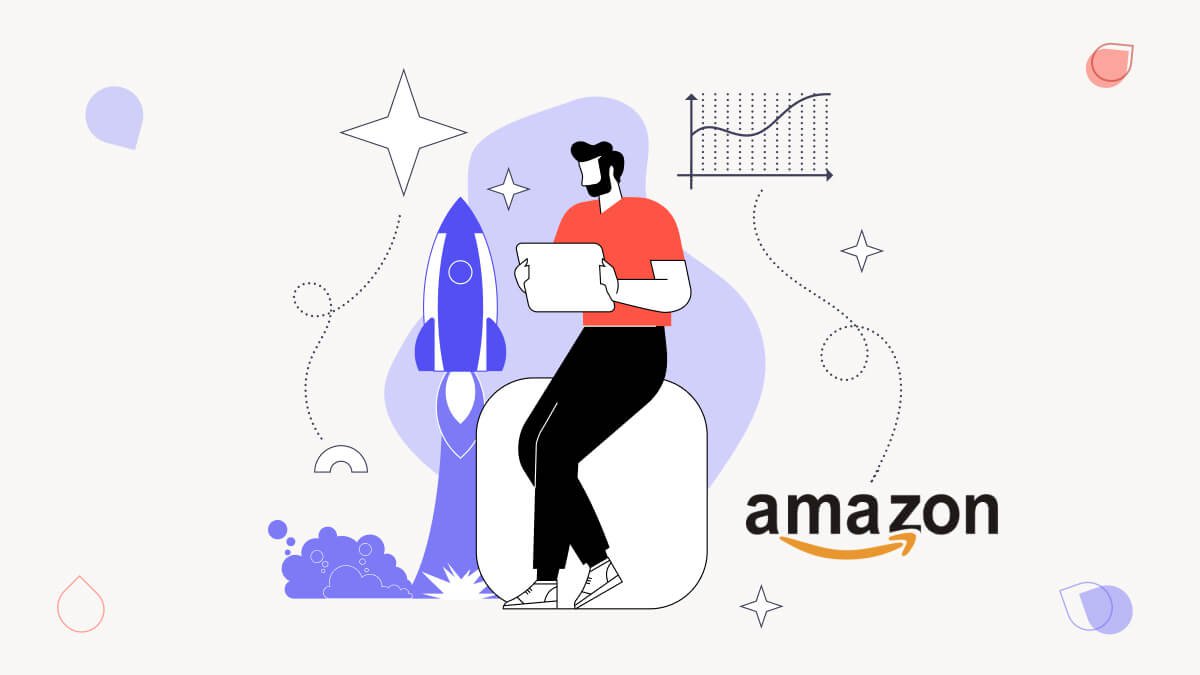
Amazon continues to be one of the biggest players in eCommerce, with a 37.8% market share in the U.S. and servicing virtually every corner of the globe. That’s more than one-third of all eCommerce sales in the U.S., happening on one platform.
And yet, it’s a super competitive space within the platform, itself. There are more than 75 million products in Amazon’s inventory and 6 million third-party sellers. So, if you want to sell on Amazon, you have to do everything you can to leave the competition in the dust and win those first spots on the Amazon product listing page.
A solid Amazon PPC strategy can help you with that. An Amazon PPC strategy complements your organic sales strategy. In this article, we break down what Amazon Ads are, how they work, what different campaign types are, and how they can get you more sales on the world’s biggest eCommerce platform.
(Source: Statista)
What is Amazon PPC?
Amazon pay-per-click (PPC), also known as Amazon sponsored ads, is an auction-style paid advertising platform. It allows third-party Amazon sellers and brands to buy ads for targeted exact phrase keywords and show their sponsored products as the first results in Amazon’s search as sponsored ads.
Amazon PPC advertisers pay for clicks only, not impressions. That means you only pay for actual clicks, regardless of the multiple types of search results your ad will show up in. Depending on the popularity of the product, those searches might take place hundreds or even thousands of times per month!
This helps you stand out from your competition while keeping costs low. It’s also especially useful in getting the ball rolling on a new product launch when you still don't have any sales or reviews.
Amazon PPC campaigns are useful in a variety of situations. They can help you
- Stand out from your competitors
- Launch a new product that has no sales or review history
- Boost your product’s performance and organic ranking
Looking for an Amazon Ads Expert? Find one on Mayple. We'll match you with one of our hand-picked marketers with proven experience, within 72 hours.
How does the Amazon PPC auction work?
Amazon PPC auction works similarly to Google PPC bidding. You submit a bid on the exact keywords you want to target, and then compete with other advertisers for the ad space.
Your cost per click needs to be 0.01 above your competitor's next lowest bid. So, for instance, if your bid is $1.00 and the next lowest bid is $0.75 you will pay $0.76.
When should I launch Amazon PPC ads?
Launch your Amazon advertising strategy and campaigns as soon as you create a new listing. In addition to getting more exposure to your new product, launching your Amazon PPC ad campaign early will also help you collect more ad data on the product. This allows you to better optimize your campaign, targeting the exact keywords that people can use to search for your product and complementary products.
Is Amazon PPC worth it?
Yes! Amazon PPC is worth it. Many consumers start their shopping directly on Amazon, and more vendors and brands are competing for top search results on Amazon’s product listing pages. Having a great Amazon PPC strategy enables you to push your product to the top of the search, so you can get more eyes on your Amazon product page.
According to AdBadger, the average Amazon CPC (Cost-per-Click) is $0.89 and the average Amazon conversion rate is 9.87%. By comparison, the average conversion rate on other eCommerce platforms is 1.33%.
Of course, these are averages, and they vary from one industry to another, but they give you a good ballpark number on why Amazon PPC ads are worth it.
With over 300 million products on Amazon, your listing can easily get lost among your competitors no matter how good it is. An Amazon PPC strategy helps you reach millions of potential new clients for a good price. So definitely consider investing in good Amazon PPC.
Want to launch an Amazon PPC strategy? Determine what your advertising budget is, and how you can maximize its impact. That means identifying the keywords people use to search for your products and complementary products, what profit margin works for your business, and how to improve your sponsored products too.
(Source: AdBadger)
Why should I try Amazon PPC?
A well-built Amazon PPC strategy gets you visibility for your products and a competitive edge in the marketplace. It’s also a great tool to boost your product rankings, as sponsored ads tend to appear in more prominent positions on the search engine results page. This drives traffic to your product page and increases organic sales.
By investing in a good Amazon PPC strategy, you can tap into the huge buying potential of Amazon customers and reach a larger audience.
Consider the incredible impact Amazon can have on your business: it registers more than 18 orders every second and more than 66,000 orders per hour. This leads to approximately 1.6 million packages shipped each day!
There's even more good news: the entry fee on Amazon PPC is very low, and you can customize your campaigns as more data and sales come in to maximize results. Start with as low as $5, test the waters, and then gradually increase your Amazon ad spending. Both the investment and the ease of the bidding system on Amazon PPC make it a low, minimal-risk enterprise. As you gather more data, you can increase or allocate your advertising budget in different ways.
Amazon is unique compared to other PPC channels in the sense that you can show your product listings to customers who are actively searching for products like yours. So, there's a direct correlation between the money you spend on PPC and how many sales you can generate. This is why it's important to pay attention to your click through rate, how it impacts your clicks into sales rate, and advertising cost of sales.
This isn't necessarily true on other PPC platforms.
On social media platforms, for example, people are mainly there to socialize, or mindlessly scroll down their feeds. This makes it harder to find an interested audience for your sponsored brands product.
Likewise, depending on the search intent, people aren't always looking for an immediate purchase on Google. As for Display ads, they get your potential buyer's attention, but they still might not be ready to make an actual purchase.
But people go on Amazon and search for a product when they're most ready to buy. They are looking for the best product for their needs, and ads on Amazon can help your product page capture their attention. An important tip here is to remember that successful campaigns utilize high-performing keywords and visually appealing product images. This makes it much easier to convert clicks into sales, and get a solid return on investment on your Amazon PPC.
» Want to improve your ad performance? Check out our ChatGPT prompts for your ads campaigns.
What are the Amazon Ads pricing and fees?
Amazon's digital advertising cost is set via a keyword auction so prices can fluctuate based on your industry. Depending on your product category, season, and competition, you can start paying from $0.01 to several dollars per ad.
How much you spend on Amazon ads depends entirely on your budget and your campaign objectives. The more competitive the environment, the higher the Amazon CPC and the cost of your ads.
The best way to get the most bang for your buck is to experiment with smaller sums of money and adjust your budget according to the results. Then you can calculate the average cost for ads and profit margin for the sponsored product.
6 Benefits of using Amazon PPC ads
Amazon PPC can be a complete game-changer for your eCommerce business for several reasons:
Increases your product sales
Amazon ads are an effective way to reach out to potential buyers and boost your product’s visibility. By targeting the right, most relevant keywords, and optimizing your campaign settings and ad copy, you can get more impressions, clicks, and sales.
Use a search term report to identify high-performing keywords and long-tail keywords, and to avoid low-performing keywords. This helps you determine how you want to balance your keyword bid strategy amongst the different types of keywords.
Looking for a tool to help improve your campaign performance? Check out our list of the best Amazon PPC software.
Boosts your organic rankings
The more people see your product page and buy from it, the better it will rank in the organic search results. Sponsored ads drive more traffic to your page, allowing it to rank higher faster, and become more visible in Amazon’s search system. That means more organic sales.
Creates brand awareness
If you’re just launching your product or are looking to expand your brand into new markets, Amazon PPC is a great way to do that.
The Mere Exposure Effect (also known as the familiarity principle) states that people develop a preference for things merely because they are familiar with them. Amazon ads can help you reach out to more people and increase brand recognition. Successful awareness campaigns use a bidding strategy that focuses on keywords that will get larger amounts of impressions, so more people see the ad.
Prevents competitors from snatching positions
Organic rankings can be hard to achieve, but with the help of Amazon PPC, you can easily get your product in front of potential customers. This way, you can secure the top positions ahead of your competitors. The easiest way you can start achieving success with Amazon PPC is by using automatic targeting campaigns, but for more control over your ads, manual targeting is the way to go.
Gets you the Amazon Buy Box
The Buy Box has a direct impact on sales, making it one of the most important elements on Amazon. It’s a box on the right side of the product page, where customers can click to purchase your product. Securing the Buy Box helps you get more clicks and sales, as it’s the most visible area of the page.
Amazon ads can help you achieve this faster.
This is particularly important for gaining momentum during seasonal sales. When the holiday season arrives or special events come around, your product needs to stand out. Amazon PPC ads will help you do just that with automatic targeting, which allows more customers to find your individual products on the platform.
Gets you real-time feedback
Amazon product ads get you valuable customer feedback and data in real-time. You can generate search term reports and overall advertising reports to make data informed decisions on how to update your Amazon PPC ads, optimize your product page, or fine-tune your key metrics.
For example, if your offer appears as the first result in searches, but people aren't clicking on it, you may need to adjust your pricing or your presentation. Or if people click on the ad but don't complete the purchase, there may not be enough convincing details on your product page. It could also mean that you could need to shift your campaign strategy from an automatic campaign to a manual campaign or vice versa.
Amazon ads can be a great way to increase your paid and organic sales, boost visibility, and reach out to potential buyers. Whether you’re just launching your product or are looking to gain a competitive advantage, Amazon PPC can help you achieve those goals. With the right strategy, targeting high-performing keywords, and daily budget, you can get more clicks and sales in no time!
Now that you know about the benefits of Amazon Ads, let’s look at the different types you can create.
Types of Amazon Ads
There are three main types of Amazon advertising: Sponsored Products, Sponsored Brands, and Product Display Ads.
Amazon Sponsored Products
Sponsored Product ads are displayed on the top of Amazon’s search results pages. They look just like organic listings but feature a "Sponsored" tag.
This type of ad drives traffic to your product listings. With sponsored products, it's important to have a variety of goals and to develop performance metrics to monitor ad performance, sales, and profit margins. Ultimately, this will help you determine the ROI of your sponsored product ads.
Amazon Sponsored Brands
Amazon's sponsored brands advertising option enables you to advertise your Amazon storefront or a collection of products on top of Amazon’s Search Engine Results Pages. You can do this with images or videos as you see fit. Keep in mind that Amazon video ads tend to be more engaging.
Sponsored brands include the brand logo, a headline, and multiple product offerings. This type of ad appears in more noticeable places on Amazon, so people who are looking for products like yours discover your store.
Sponsored Display
Amazon Sponsored Display ads and Amazon DSP are audience-based and allow you to target specific demographics or retarget a visitor to your product. The ads usually run on both Amazon and external websites, maximizing your reach and your Amazon PPC strategy.
Amazon PPC terms you need to know
There are multiple ways to bid on an Amazon keyword. Here are some essential terms you need to know to make the best choice for your Amazon PPC strategy.
Broad match
Broad match is a keyword match type with the widest reach. With broad match keywords, your ads will appear when all the keywords are present, regardless of the order. So, for example, if your keyword is "Women's Shoes," your ad will show for "Flat Red Shoes Women's" searches, too.
Phrase match
When you choose a phrase match for your Amazon keyword, your ad will show when your entire phrase matches the exact order in the search term, including words before or after it. So for the "Women's Shoes" keyword, your ad will appear when someone searches for "Red Women's Shoes" or "Red Women's Shoes high heels" but not "Women's Winter Shoes."
Exact match
When you choose the Amazon exact match bidding strategy for a given keyword, your ad will only show when someone searches with the exact keyword. So continuing with the "Women's Shoes" keyword as an example, your ad will appear when someone searches for "Women's Shoes" only. It won't appear in search results for "Red Women's Shoes." Exact match keywords work when you know how your potential and current customers search for your individual products.
Dynamic bidding
When setting up a sponsored products campaign, select from different bidding strategies. "Dynamic bids - up and down" is the most popular one, where Amazon’s algorithm will raise or lower your bid based on the likelihood of the potential click converting to a sale.
That means they will increase your bids in real-time to help win impressions that may be more likely to convert to a sale or reduce your bids for those less likely to convert to a sale.
Dynamic bidding is more suitable for sellers who want to be more hands-off with their Amazon PPC strategy and don't need to have that much control over what happens with their ads.
Negative keywords
Negative keywords prevent your ad from appearing in the wrong searches. When you review your search term report, you can compile a negative targeting list. For example, when advertising men's shoes you'd add “women” as a negative keyword to prevent your product ads from showing up when someone is searching for women’s shoes.
Add negative keywords to your ads at the campaign and ad levels during campaign setup. There are two types of negative keywords: negative phrase match and negative exact match keywords.
Psst: Are you looking for a top-notch Amazon PPC expert? Hire one through Mayple. We’ve got hundreds of vetted experts with proven experience in your niche.
Impressions
An ad impression is "the number of times an ad is displayed on a screen." In other words, if your ad has 1,000 impressions, Amazon has shown it 1,000 times to people who fit the campaign criteria. Focus on improving your campaign's impressions if increase your brand awareness is one of your main goals.
Clicks
“Clicks" represent the number of times someone clicks on your Amazon ad. For instance, say your ad appears to 1,000 people when they search for a product on Amazon and 100 of them click on it. That means your click-through rate is 10%.
Amazon key performance indicators (KPIs)
Amazon key performance indicators (KPIs) are metrics used to measure the success of an Amazon advertising campaign. These are important for determining if your campaigns are performing as expected and making adjustments accordingly.
Without the right KPIs, however, you are blindfolded to what works and what doesn't when it comes to your Amazon PPC campaigns. Then you risk pouring a lot of money into campaigns that don't bring the ROI home. The best professional sellers measure key metrics against all of their business activities to determine their effectiveness.
ACOS
The advertising cost of sales (ACOS) is one of the most important metrics used to measure your Amazon advertising campaigns. It compares the amount spent versus the amount earned and helps determine if your campaigns are cost-efficient. Here's how you calculate the ACoS rate:
Source: ProfitWhales
CPC
Amazon CPC (or cost per click) is how much each click on your Amazon PPC costs. This is one of the most important metrics to track to stay within a reasonable daily budget. The Amazon CPC can depend on a lot of factors, including your competitors' bids and the relevant keyword you’re targeting, the negative keywords you want to exclude, as well as your industry, seasonality, and other factors.
Successful campaigns are optimized to have a low CPC, which is high impact at a low cost. Professional sellers should keep in mind that the CPC needs to be proportionate to their profit, including paid and organic sales.
CTR
Click-through rate is the ratio of users who click on an ad to the total number of users who see it. Calculate your CTR by dividing your total number of impressions on an ad by its number of clicks.
Source: ProfitWhales
If your ad appears to 1,000 people when they search for a product on Amazon, and 100 people click on it, your click-through rate is 10%.
Conversion Rate
Your conversion rate is the rate of how many times your ad converts into a sale. To calculate your CVR (a.k.a. CR), divide the total number of clicks by the units sold. While a high rate of ad impressions and clicks can feel good, at the end of the day, your PPC conversion rate drives the revenue. Your campaign should be optimized to increase CVR as much as possible. One way to do this is to frequently monitor your campaigns to determine the high-performing keywords you should target.
What's the difference between automatic campaigns and manual campaigns?
There are advantages and disadvantages to both types of campaigns. And both have a place. The important thing is to know when to use each type of campaign.
Automatic campaigns are useful when you want to
- reach a broader target audience
- target a trend
- enjoy easy setup
- spend less time on keyword research
One downside, though, is that you can potentially waste ad spend.
Manual campaigns are important for
- long-term growth
- product launches
- targeting broad or exact keywords and phrases
- more efficient ad spend
Keep in mind, though, that it does take a longer time for campaign setup and optimization.
Successful campaigns utilize a combination of both campaigns, so you have immediate and long-term success.
Should you manage your Amazon PPC or outsource to an agency?
Getting started, you should manage the Amazon PPC yourself to get to know the platform. As your campaigns become more complex and you require greater expertise, consider hiring an Amazon expert or agency.
Working with an Amazon marketing agency costs more, but they'll (hopefully!) use the right strategies to get better results, and ultimately improve your profit margin. With the many different ad types, having an expert who can help you select the right one is pivotal to creating successful Amazon PPC ads. For example, you could start running automatic campaigns, but an expert could evaluate its performance and decide a manual campaign would perform better.
They'll be able to create an Amazon PPC strategy from scratch, optimize your campaigns, run your Amazon PPC management, provide advertising reports so you know how your ads are performing, and make sure every cent you spend is getting you the best possible return. Plus, they will also be able to save you time, which you can use to focus on other aspects of your business.
Ultimately, it's up to you to decide if the extra cost is worth it. But if you have the proper budget allocation and need to maximize the results of your Amazon PPC campaigns, outsourcing to an agency could be a great option.
Amazon PPC requirements and what you need to get started
Ready to start running your own Amazon PPC strategy and see where it goes? Congrats! Amazon PPC requirements and campaign setup aren’t extremely complicated, so you’ll be up and running in no time. Here’s what you need to get started:
A valid Amazon Seller Central account and approved products
To run ads on Amazon, you need three things for campaign setup, including an Amazon Seller Central account and an approved product. Generally, Amazon Seller Central will approve you within 24 hours, so you won't have to wait for too long to get started.
A product description and product images
A well-crafted product description and appealing product images will help your Amazon PPC campaigns to stand out. Make sure you have a detailed, keyword-rich product description written according to Amazon SEO best practices. Also, make sure your description is enticing enough to convince users to make a purchase.
As for product images, always ensure they're clear, relevant, and high-quality. A low-quality product image can deter someone from buying the product, as it doesn't inspire trust, and it might make potential customers wary of buying from you.
A list of keywords you want to bid on
You also need a list of keywords that you want to bid on. You can use Amazon's built-in keyword research tools to find the keywords most relevant to your product and needs. Keep in mind that you can use the same list of keywords for your Amazon SEO (organic marketing efforts). Compile a list of keywords that includes exact phrase terms or long-tail keywords, a mixture of keywords with different search volumes, and a negative targeting list.
Amazon PPC: A great tool for seller success
Getting started on Amazon PPC is easy, and it can be quite inexpensive, too. With the benefits of running Amazon advertising and the potential to drive significant revenue, Amazon PPC is an attractive option for sellers across all industries. So, if you're serious about scaling your business, try it out!
Whether you sell a unique product or you work in an Amazon reseller marketing department, Amazon PPC can help you maximize your ROI and get the most out of every single penny. Keep an eye on your ad spending and how it ties to clicks and sales performance, and then adjust according to your business needs.
Looking for a PPC consultant? Find one on Mayple. Hand-picked marketers with proven experience, hire in 72 hours.
FAQs
What are the 3 types of Amazon PPC campaigns?
There are three main types of Amazon PPC campaigns:
- Sponsored Products for advertising individual products
- Sponsored Brands for promoting your brand or Amazon storefront
- Sponsored Display for targeting customers who have recently interacted with your product or brand, as well as creating campaigns based on specific demographics
What is PPC in Amazon?
Amazon PPC is a pay-per-click advertising network that allows Amazon sellers to buy ad space on Amazon listing pages. Every ad placement is purchased using a keyword auction and the seller is charged based on how many clicks their ad receives.
The goal is to create a campaign bidding strategy that targets the most important keywords for your products.
Is Amazon PPC profitable?
Amazon PPC has a higher click-through rate than any other PPC platform, so, yes, it can be quite profitable. It all depends on your campaign setup, how competitive your space is, how well you choose your main keywords and negative keywords, and what budget allocation looks like for Amazon PPC. All in all, running product ads on Amazon makes for an exciting and profitable proposition.
How does Amazon bill for PPC?
Amazon Advertising will charge your credit card for the PPC campaigns you run on the platform. Since Amazon accepts all major credit card companies, it's unlikely you'll have any trouble paying for your ad campaigns.
How much should I budget for Amazon PPC?
How much you should budget for Amazon PPC depends on the product category, but the general industry rule of thumb is 10% of your total sales. This number is just a guideline, so be sure to adjust it to your specific needs and performance.
What is the minimum daily budget for Sponsored Products and Sponsored Brands Ads?
For Sponsored Products and Sponsored Brand ads on Amazon Advertising, your minimum daily budget should be $1. For Display campaigns, you must have a minimum daily budget of $10 if you want to use performance-based rules.

